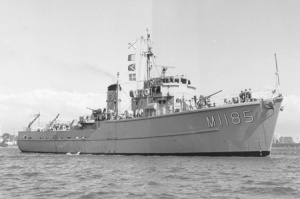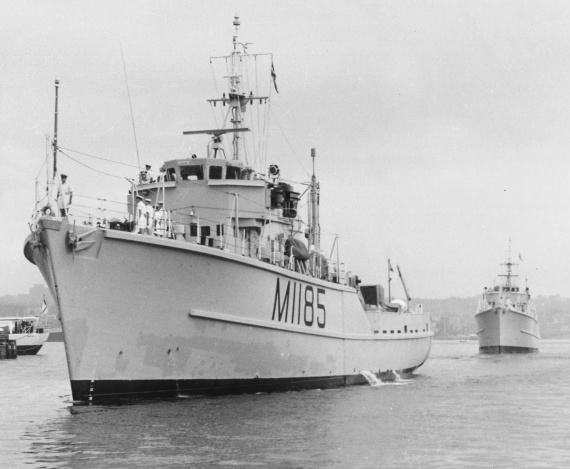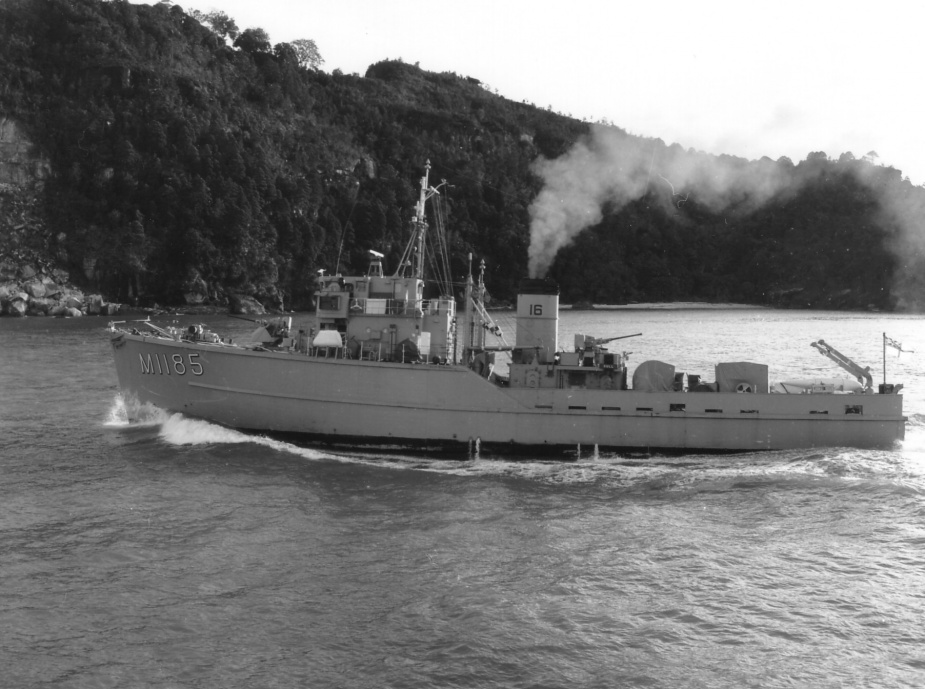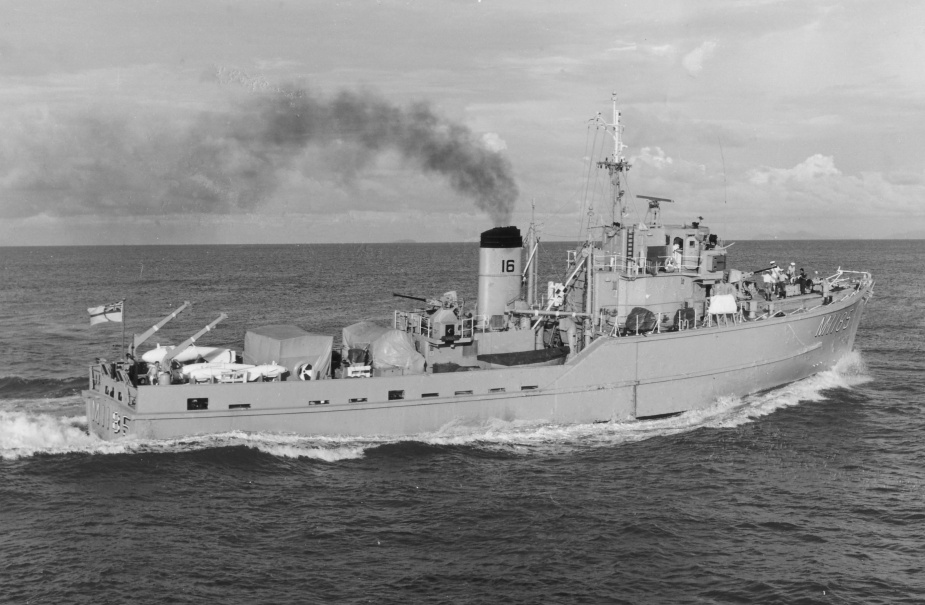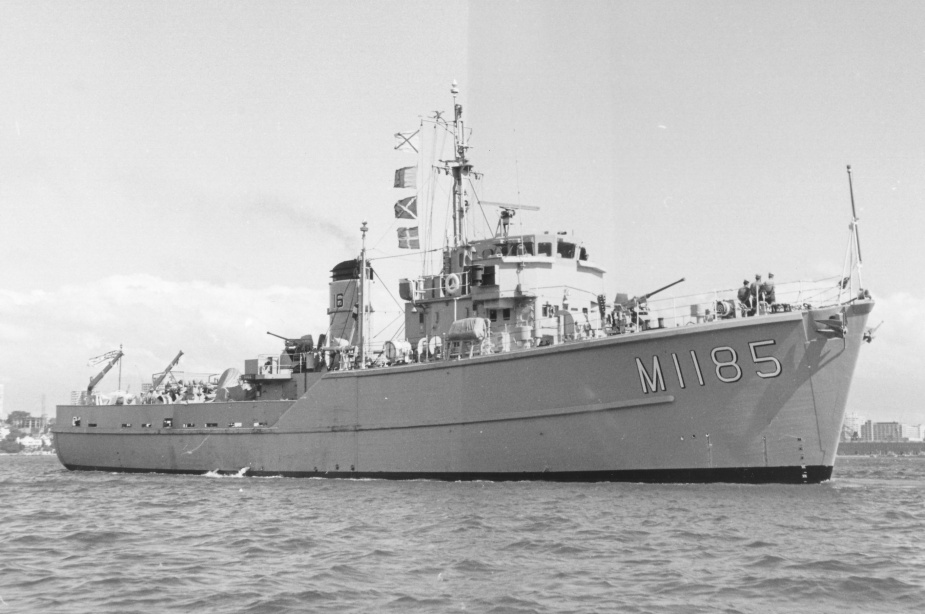HMAS Gull
| Class |
Ton Class |
|---|---|
| Type |
Minesweeper |
| Pennant |
M1185 |
| Builder |
JS Doig, Grimsby |
| Launched |
1 July 1954 |
| Commissioned |
19 July 1962 |
| Decommissioned |
7 November 1969 |
| Dimensions & Displacement | |
| Displacement |
|
| Length | 46.6 metres (152 feet) |
| Beam | 8.8 metres (29 feet) |
| Draught | 2.5 metres (8 feet) |
| Performance | |
| Speed | 15 knots |
| Complement | |
| Crew | 38 |
| Propulsion | |
| Machinery | 2 Napier Deltic diesels |
| Horsepower | 3000 bhp |
| Armament | |
| Guns | 1 single 40/60 Bofors |
| Awards | |
| Battle Honours | MALAYSIA 1964-66 |

HMAS Gull was one of six ex-Royal Navy Ton Class minesweepers acquired by the Royal Australian Navy (RAN). Her sister ships were HMA Ships Curlew, Hawk, Snipe, Ibis and Teal. The six Ton Class minesweepers formed the 16th Mine Countermeasures (MCM) Squadron and provided the RAN with the means to gain and maintain proficiency in mine countermeasures.
Gull was originally accepted into Royal Navy service as HMS Swanston on 27 July 1955. Upon completion of trials she was moved to White’s Shipyard, Itchen, for preservation and storage in the Royal Navy’s Reserve Fleet at Hythe. She was purchased by the RAN in 1961 and commissioned as HMAS Gull on 19 July 1962, under the command of Lieutenant BJ Dunn, RAN. She arrived in Sydney with her sister ships on 7 December 1962.
On 4 February 1963, Gull commenced her service with the RAN, proceeding to the Broken Bay area for manoeuvres and mine countermeasures exercises with Teal and Hawk. Her participation was curtailed several times due to defects, which required her to return to Sydney on three occasions.
On 20 September 1963, Gull and her sister ships sailed for their first overseas deployment as part of Operation GARDENING, a minesweeping task to clear a channel into Tonolei Harbour in Bougainville, where US aircraft had dropped a large number of magnetic mines in 1943. This was the RANs biggest minesweeping operation for 16 years. The deployment also included overseas port visits to Singapore and Port Moresby, and the conduct of hydrographic surveys in the Solomon Sea and Chestnut Bay (125 miles south east of Port Moresby). The Squadron returned to Sydney that December.
In refit until early March 1964, Gull participated in mine countermeasures exercises in the local exercise area until May. On 1 May 1964, and in company with Hawk, she sailed for her first Far East Strategic Reserve deployment as part of Australia’s commitment to Commonwealth support for Malaysia during the Indonesian Confrontation. The two MCMs began their patrol duties on 9 June and were relieved by their sister ships, Ibis and Teal, on 30 August. On her return to Sydney in late September, Gull entered Garden Island Dockyard for a mid-cycle docking prior to redeploying to the Far East from January to August 1965. Gull again returned to the Far East in January 1966. During this deployment, the Naval Board decided that, rather than ships wasting time and resources returning to Australia between deployments, the ships would remain on station and crew changes and any necessary maintenance would occur at one of the Royal Navy bases in Singapore or Hong Kong. On 13 August 1966, following ratification of the Bangkok Accord, orders for the cessation of patrols were received. Gull and Hawk remained in the Strategic Reserve, however, undertaking tasks such as Duty Coastal Minesweeper until early April 1967 when they departed for Sydney.
Upon her return to Australia, and due to increasing maintenance costs and personnel shortages, Gull was paid off into operational reserve on 5 May 1967. On 16 February 1968, however, she was recommissioned into service under the command of Lieutenant RN Walker, RAN.
The following weeks were busy for Gull and her new crew with a wide range of exercises on the Australian coast. During a visit to Launceston on 15-18 March she acted as flagship for the 129th Launceston Regatta. Returning to Sydney on 22 March, she replaced Hawk as the flag-ship at the 1968 Olympic Sailing Trials.
From late April until early July 1968, and in company with Hawk and Snipe, she completed a South East Asian deployment during which she participated in Exercises SMALL FRY and SHORT PLAY with units from the Royal Navy, and the United States and Philippines Navies.
Gull deployed overseas once again to Papua New Guinea in September in company with Hawk and Snipe where the three MCMs swept an approach channel to Marshall Lagoon. She operated in Australian waters for the remainder of the year, participating in Exercise SHADOW in October and a National Mapping Survey of the Coral Sea and outer Barrier Reef in November.
Following a period of maintenance and workup, Gull, in company with Hawk and Curlew, deployed for the Far East on 17 March 1969. The three ships took the more circuitous route along Australia’s southern coastline enabling them to survey an approach channel off Anglesea, Victoria. They arrived in Singapore on 21 April to participate in Exercise JUGGLER in East Malaysian waters with units from the Royal Navy and Royal Malaysian Navy, and the South East Asia Treaty Organisation Exercise SEA SPIRIT involving more than 60 naval units from Australia, New Zealand, the Philippines, Thailand, the United Kingdom and the United States. On 3 June 1969, the SEATO exercise was postponed following the HMAS Melbourne/USS Frank E Evans collision. The mine countermeasures phase of the exercise recommenced the following day. Gull arrived home on 1 July.
During the period 25-28 August 1969, Gull, together with other RAN units, was involved in a search for survivors from the merchant vessel, Noongah, which had foundered in heavy seas off Smoky Cape. She sailed for her final deployment prior to decommissioning on 30 August to conduct a National Mapping Offshore Survey of the Coral Sea area.
On 7 November 1969, Gull was paid off into operational reserve having steamed 199,042.7 nautical miles in almost seven years of active service. In a fitting postscript, Gull was awarded the Kelly Shield for small ship efficiency in 1969, however, as Gull had already paid-off, the shield was presented to Ibis in which most of Gull’s crew were now serving.
Gull remained in the Reserve Fleet until 20 January 1976 when she was finally sold. By this time she had been comprehensively stripped to provide spare parts for Curlew, Ibis and Snipe.

